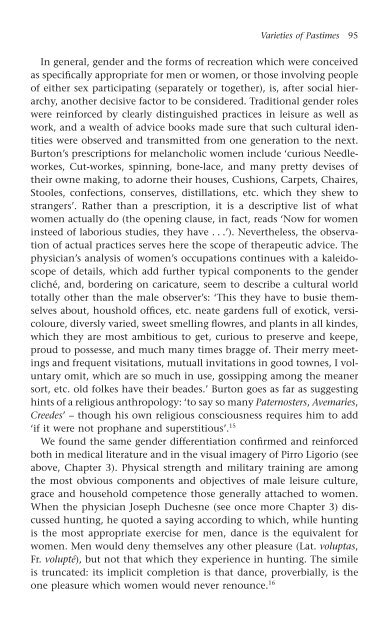Recreation in the Renaissance
Recreation in the Renaissance
Recreation in the Renaissance
- No tags were found...
You also want an ePaper? Increase the reach of your titles
YUMPU automatically turns print PDFs into web optimized ePapers that Google loves.
Varieties of Pastimes 95<br />
In general, gender and <strong>the</strong> forms of recreation which were conceived<br />
as specifically appropriate for men or women, or those <strong>in</strong>volv<strong>in</strong>g people<br />
of ei<strong>the</strong>r sex participat<strong>in</strong>g (separately or toge<strong>the</strong>r), is, after social hierarchy,<br />
ano<strong>the</strong>r decisive factor to be considered. Traditional gender roles<br />
were re<strong>in</strong>forced by clearly dist<strong>in</strong>guished practices <strong>in</strong> leisure as well as<br />
work, and a wealth of advice books made sure that such cultural identities<br />
were observed and transmitted from one generation to <strong>the</strong> next.<br />
Burton’s prescriptions for melancholic women <strong>in</strong>clude ‘curious Needleworkes,<br />
Cut-workes, sp<strong>in</strong>n<strong>in</strong>g, bone-lace, and many pretty devises of<br />
<strong>the</strong>ir owne mak<strong>in</strong>g, to adorne <strong>the</strong>ir houses, Cushions, Carpets, Chaires,<br />
Stooles, confections, conserves, distillations, etc. which <strong>the</strong>y shew to<br />
strangers’. Ra<strong>the</strong>r than a prescription, it is a descriptive list of what<br />
women actually do (<strong>the</strong> open<strong>in</strong>g clause, <strong>in</strong> fact, reads ‘Now for women<br />
<strong>in</strong>steed of laborious studies, <strong>the</strong>y have . . .’). Never<strong>the</strong>less, <strong>the</strong> observation<br />
of actual practices serves here <strong>the</strong> scope of <strong>the</strong>rapeutic advice. The<br />
physician’s analysis of women’s occupations cont<strong>in</strong>ues with a kaleidoscope<br />
of details, which add fur<strong>the</strong>r typical components to <strong>the</strong> gender<br />
cliché, and, border<strong>in</strong>g on caricature, seem to describe a cultural world<br />
totally o<strong>the</strong>r than <strong>the</strong> male observer’s: ‘This <strong>the</strong>y have to busie <strong>the</strong>mselves<br />
about, houshold offices, etc. neate gardens full of exotick, versicoloure,<br />
diversly varied, sweet smell<strong>in</strong>g flowres, and plants <strong>in</strong> all k<strong>in</strong>des,<br />
which <strong>the</strong>y are most ambitious to get, curious to preserve and keepe,<br />
proud to possesse, and much many times bragge of. Their merry meet<strong>in</strong>gs<br />
and frequent visitations, mutuall <strong>in</strong>vitations <strong>in</strong> good townes, I voluntary<br />
omit, which are so much <strong>in</strong> use, gossipp<strong>in</strong>g among <strong>the</strong> meaner<br />
sort, etc. old folkes have <strong>the</strong>ir beades.’ Burton goes as far as suggest<strong>in</strong>g<br />
h<strong>in</strong>ts of a religious anthropology: ‘to say so many Paternosters, Avemaries,<br />
Creedes’ – though his own religious consciousness requires him to add<br />
‘if it were not prophane and superstitious’. 15<br />
We found <strong>the</strong> same gender differentiation confirmed and re<strong>in</strong>forced<br />
both <strong>in</strong> medical literature and <strong>in</strong> <strong>the</strong> visual imagery of Pirro Ligorio (see<br />
above, Chapter 3). Physical strength and military tra<strong>in</strong><strong>in</strong>g are among<br />
<strong>the</strong> most obvious components and objectives of male leisure culture,<br />
grace and household competence those generally attached to women.<br />
When <strong>the</strong> physician Joseph Duchesne (see once more Chapter 3) discussed<br />
hunt<strong>in</strong>g, he quoted a say<strong>in</strong>g accord<strong>in</strong>g to which, while hunt<strong>in</strong>g<br />
is <strong>the</strong> most appropriate exercise for men, dance is <strong>the</strong> equivalent for<br />
women. Men would deny <strong>the</strong>mselves any o<strong>the</strong>r pleasure (Lat. voluptas,<br />
Fr. volupté), but not that which <strong>the</strong>y experience <strong>in</strong> hunt<strong>in</strong>g. The simile<br />
is truncated: its implicit completion is that dance, proverbially, is <strong>the</strong><br />
one pleasure which women would never renounce. 16










